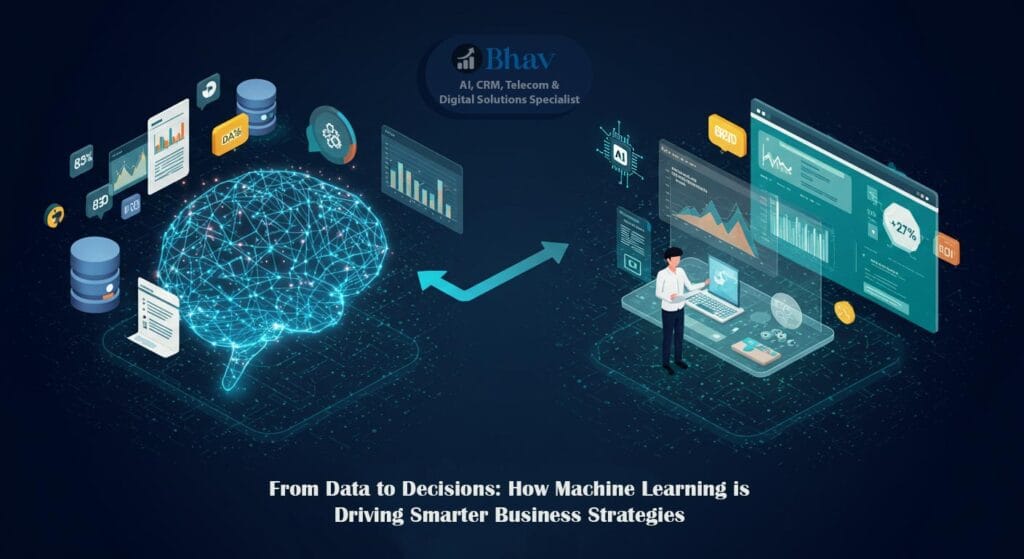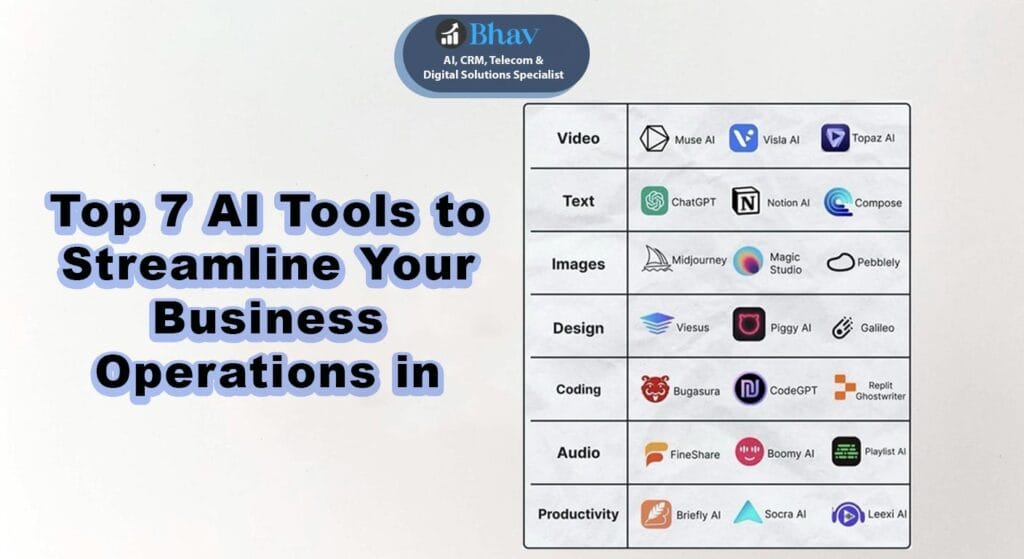
Introduction to Machine Learning in Business
Machine learning (ML) represents a significant technological advancement that has transformed various sectors, particularly the realm of business. At its core, machine learning is a subset of artificial intelligence that enables systems to learn from data, identify patterns, and make decisions with minimal human intervention. Over the last decade, the growth in computational power and accessibility of large data sets has propelled ML into a critical role within corporate strategies.
Modern businesses are increasingly discovering the power of data-driven decision-making, emphasizing the importance of analytics in shaping strategies. By leveraging machine learning algorithms, organizations can analyze vast amounts of data and draw actionable insights. This capability allows companies to forecast trends, improve customer experiences, and optimize internal processes, resulting in smarter business strategies. The evolution of these systems has shifted the business landscape, as companies now rely on predictive analytics to maintain a competitive advantage.
Machine learning’s impact extends beyond basic data processing; it encompasses advanced analytics that inform crucial business decisions. For instance, ML models can enhance customer relationship management by predicting customer preferences, thus enabling businesses to tailor their offerings effectively. Additionally, industries such as finance are utilizing machine learning for credit scoring and fraud detection, which exemplifies how data analytics can mitigate risks and enhance profitability.
This shift towards machine learning highlights a broader trend of integration between technology and strategic planning. Embracing ML means more than just adopting new technologies; it signifies a commitment to being guided by data insights, ultimately leading to innovative solutions and improved operational efficiency. As organizations continue to navigate this evolving landscape, the strategic application of machine learning will become increasingly vital for achieving long-term business objectives.
Understanding Predictive Analytics
Predictive analytics is an advanced analytical technique that utilizes historical data, statistical algorithms, and machine learning to identify the likelihood of future outcomes based on past events. By leveraging this powerful tool, businesses can forecast trends and behaviors, allowing them to make informed decisions that enhance their strategic initiatives. The core of predictive analytics lies in its ability to convert raw data into actionable insights, which is increasingly vital in today’s data-centric landscape.
The application of machine learning algorithms is essential in predictive analytics, as these algorithms continuously learn from new data and improve their predictive accuracy. Traditional statistical methods may fail to capture complex patterns in data; however, machine learning excels in identifying correlations that may not be immediately apparent. Techniques such as regression analysis, decision trees, and neural networks play crucial roles in empowering predictive models, enabling businesses to anticipate customer needs, market shifts, and operational challenges.
In the realm of business strategy, the importance of predictive analytics cannot be overstated. Organizations that harness the power of predictive models benefit from improved efficiency, optimized resource allocation, and enhanced customer satisfaction. For example, businesses can forecast inventory needs more accurately, reducing inefficiencies and costs associated with overstock or stockouts. Additionally, predictive analytics can help companies identify customer segments that are more likely to respond positively to marketing campaigns, thus increasing return on investment.
Ultimately, the integration of predictive analytics into business operations not only facilitates smarter decision-making but also fosters a culture of data-driven strategy development. As organizations continue to adapt to an ever-changing market landscape, the adoption of predictive analytics will likely become a cornerstone of competitive advantage.
Real-World Applications of Machine Learning
Machine learning (ML) has become a transformative technology across various sectors, driving efficiency and enhancing decision-making processes in business environments. In finance, ML algorithms are widely employed for fraud detection. By analyzing vast amounts of transaction data, these systems can identify unusual patterns that indicate potential fraudulent activities. For example, organizations are using supervised learning techniques to classify transactions as legitimate or suspicious based on historical data, allowing them to respond swiftly to prevent significant losses.
In the retail sector, machine learning has proved invaluable for customer segmentation and inventory management. Retailers use clustering algorithms to analyze purchasing behaviors, enabling them to tailor marketing strategies to different customer segments. By understanding the preferences and shopping patterns of various demographics, businesses can optimize their inventory levels and reduce excess stock. For instance, companies leverage predictive analytics to forecast which products will trend and when, thus ensuring a well-balanced inventory that meets customer needs without overstocking.
Healthcare is another sector that has benefited immensely from machine learning advancements. ML models are applied to patient data for predictive analytics, helping healthcare providers anticipate patient outcomes and streamline treatments. By analyzing electronic health records and genetic data, these systems can predict patients at risk for certain diseases, allowing for early intervention. For example, healthcare organizations are developing algorithms to identify high-risk patients for readmission, which aids in reducing costs and improving patient care.
These real-world applications illustrate how machine learning fosters innovation and efficiency across diverse industries. By harnessing the power of data, businesses can make informed decisions, optimize processes, and ultimately drive success in an increasingly competitive landscape.
Enhancing Customer Insights with Machine Learning
The integration of machine learning (ML) into business processes has revolutionized how organizations approach customer insights. By leveraging vast amounts of data, ML algorithms can analyze customer behaviors and preferences, allowing businesses to tailor their strategies for improved engagement. A prominent technique in this realm is sentiment analysis, which utilizes natural language processing to interpret customer sentiments expressed through social media, reviews, and feedback. By analyzing these sentiments, companies can gain a better understanding of customer perceptions and adjust their offerings accordingly.
Another critical method employed by businesses is behavior prediction, which involves forecasting future customer actions based on historical data. This predictive capability enables organizations to create targeted marketing campaigns that resonate with individual customers, ultimately fostering stronger relationships. For instance, if a retailer recognizes a pattern indicating that certain customers prefer specific product types, they can proactively market similar items, increasing the likelihood of conversion and enhancing the overall shopping experience.
Furthermore, the application of machine learning in customer insights leads to enhanced personalized marketing strategies. By analyzing past interactions, purchasing habits, and customer demographics, businesses can segment their audiences and create customized campaigns. Such personalization improves the customer experience, as consumers are more likely to engage with brands that offer relevant products and services tailored to their preferences.
The benefits of harnessing ML for customer insights extend beyond obtaining data-driven intelligence; it also contributes to improved customer satisfaction and loyalty. As companies deepen their understanding of clients through advanced analytics, they can identify opportunities to enhance service delivery and anticipate customer needs more effectively. Subsequently, this can lead to increased retention rates and long-term profitability.
Improving Operational Efficiency through Automation
In today’s fast-paced business environment, operational efficiency is paramount for organizations striving for competitiveness and sustainability. Machine learning (ML) technology plays a crucial role in enhancing operational efficiency by automating routine tasks and processes. Automation through ML streamlines workflows, reduces error rates, and frees up human resources for more complex and value-driven activities, thus driving smarter business strategies.
Numerous case studies illustrate the transformative impact of machine learning on operational efficiency. For instance, a prominent retail chain implemented machine learning algorithms to automate inventory management. By analyzing historical sales data and customer preferences, the system predicts demand more accurately, ensuring optimal stock levels. This not only minimizes excess inventory but also reduces operational costs associated with storage and waste. As a result, the retailer observed a significant increase in productivity, leading to improved profit margins.
Additionally, the manufacturing sector has witnessed substantial advancements through the integration of ML-powered automation. A well-known automotive company adopted predictive maintenance powered by machine learning to forecast equipment failures before they occur. This proactive approach not only reduced machine downtime but also lowered maintenance costs substantially. By automating maintenance scheduling, the organization optimized its operational efficiency, allowing for maximized production capability and reduced resource wastage.
Furthermore, many service industries, such as customer support, are leveraging ML-driven chatbots to handle routine inquiries. These automated systems provide immediate responses to customer requests, thereby enhancing user experience while allowing human agents to focus on more complex issues that require critical thinking. Consequently, businesses that implement such ML solutions discover a decrease in operational costs and an increase in overall productivity, reinforcing the importance of adopting automation as a core strategy for operational efficiency.
Measuring ROI from Machine Learning Initiatives
Measuring the return on investment (ROI) from machine learning initiatives is crucial for businesses striving to maximize profitability and ensure the effective allocation of resources. To achieve this, organizations need to establish a comprehensive framework consisting of key performance indicators (KPIs) and metrics tailored to their specific goals and objectives. One of the primary KPIs to consider is the cost savings generated by automating processes or improving efficiencies. For instance, businesses can quantify the reduction in labor costs or the decrease in operational costs due to enhanced decision-making enabled by machine learning algorithms.
Another significant metric is revenue growth resulting from improved customer experiences or targeted marketing efforts. By employing machine learning models to analyze customer behavior, preferences, and purchasing patterns, businesses can create personalized marketing strategies, thus driving up conversion rates and overall sales. Additionally, assessing the financial impact of machine learning should also encompass customer retention metrics, as a reduction in churn rates can significantly contribute to long-term profitability.
Furthermore, businesses should consider the time-to-market for products or services as a measure of ROI. Reduced time frames for launching new offerings can facilitate the capture of market share and increase competitive advantages. Implementing machine learning to streamline operations, from product development to supply chain management, often leads to faster execution and better resource utilization.
It is also essential to analyze the accuracy and reliability of machine learning models as part of the evaluation process. More accurate predictions can result in better strategic decisions, ultimately leading to a direct financial benefit. By continuously monitoring and adjusting KPIs and metrics related to machine learning, organizations can ensure that they are not only measuring ROI effectively but also cultivating a culture of data-driven decision-making that supports long-term growth.
Challenges and Considerations in Implementing Machine Learning
As businesses increasingly adopt machine learning (ML) technologies to enhance decision-making processes, they encounter various challenges that can hinder successful implementation. One of the most pressing issues is data quality. Machine learning algorithms rely on high-quality data to generate accurate predictions; however, organizations often struggle with incomplete, inconsistent, or outdated information. Establishing robust data governance frameworks can help organizations ensure data integrity and reliability, providing a solid foundation for machine learning initiatives.
Another significant challenge is the skills gap within the workforce. The implementation of machine learning requires specialized knowledge in statistics, programming, and data analysis, which may not be readily available within existing teams. Consequently, businesses may find it necessary to invest in training programs or hire new talent with the requisite expertise. To bridge this skills gap, fostering a culture of continuous learning and collaboration between data scientists and domain experts can facilitate knowledge sharing and enhance the effectiveness of machine learning projects.
Integration with existing systems poses yet another challenge for organizations seeking to implement machine learning solutions. Many businesses rely on legacy systems that may not be compatible with modern ML tools. In such cases, organizations must consider conducting a thorough assessment of their current infrastructure to identify potential barriers to integration. Migrating data to cloud-based platforms or utilizing APIs can ease the transition, allowing for smoother adoption of machine learning technologies.
Moreover, addressing ethical considerations, such as bias in algorithms, is essential to ensure that machine learning models yield fair and equitable outcomes. By incorporating diverse datasets and continuously monitoring for bias, organizations can mitigate these risks. Overall, while challenges abound in implementing machine learning, addressing data quality, skills shortages, and integration issues can facilitate a successful transition toward smarter business strategies.
Future Trends in Machine Learning for Business
The landscape of machine learning is continually evolving, driven by technological innovation and the increasing demand for smarter business strategies. As organizations adopt machine learning to enhance operational efficiency and customer engagement, several emerging trends are anticipated to shape the future of this field significantly. One of the prominent trends is ethical AI, which emphasizes the responsible use of artificial intelligence systems. Businesses are recognizing the importance of building algorithms that are not only effective but also fair and transparent. This shift towards ethical AI is likely to help mitigate biases in machine learning models, fostering trust among consumers and stakeholders.
Another critical trend is the rise of explainable machine learning (explainable ML). As businesses increasingly rely on machine learning for decision-making, the need to understand the reasoning behind model predictions becomes crucial. Explainable ML facilitates this understanding, allowing organizations to provide transparency about how outcomes are derived. This is especially vital in sectors such as finance and healthcare, where accountability is paramount, and stakeholders must be assured of the decisions made by automated systems.
Data privacy is also an emerging priority that influences machine learning deployment. With rising concerns about privacy regulations and data security, companies are being urged to adopt practices that safeguard sensitive information. The integration of privacy-preserving techniques, such as differential privacy and federated learning, is expected to gain traction, allowing businesses to harness machine learning while respecting individual privacy rights. As these trends gain prominence, the intersection of technology, ethics, and compliance will drive the redefinition of strategies for businesses aiming to leverage machine learning effectively.
Conclusion: The Transformative Power of ML in Business Strategy
In today’s fast-paced and data-driven landscape, the integration of machine learning (ML) into business strategies stands out as a game-changer. The key takeaways from the discussions surrounding ML highlight its significant role in optimizing decision-making processes and enhancing operational efficiencies. As businesses encounter increasing amounts of data, leveraging advanced algorithms and analytical techniques inherent in ML can foster insightful and actionable outcomes.
The transformative power of machine learning lies in its ability to uncover hidden patterns and trends within vast datasets, which traditional analytical methods may not easily reveal. By employing machine learning, organizations can make more informed decisions that align with market demands and consumer behaviors, thereby achieving a competitive edge. Moreover, the adaptability of ML solutions allows businesses to refine their strategies dynamically, responding to real-time data inputs and shifting market conditions.
Additionally, the implementation of ML not only improves tactical decision-making but also contributes to strategic planning. As firms begin to integrate ML capabilities within their operations, they transition from intuition-based approaches to data-driven strategies that are grounded in evidence. This strategic shift is essential for companies looking to thrive in an increasingly competitive environment where data is abundant and its utilization can dictate success.
Ultimately, embracing machine learning is no longer a luxury but a necessity for businesses aiming to excel in their domains. Organizations that prioritize ML adoption will likely find themselves at the forefront of innovation and growth. As the landscape continues to evolve, those who harness the capabilities of machine learning will be well-positioned to navigate the challenges ahead, transforming data into powerful business strategies that promote enduring success.
Latest Insights
No Posts Found




